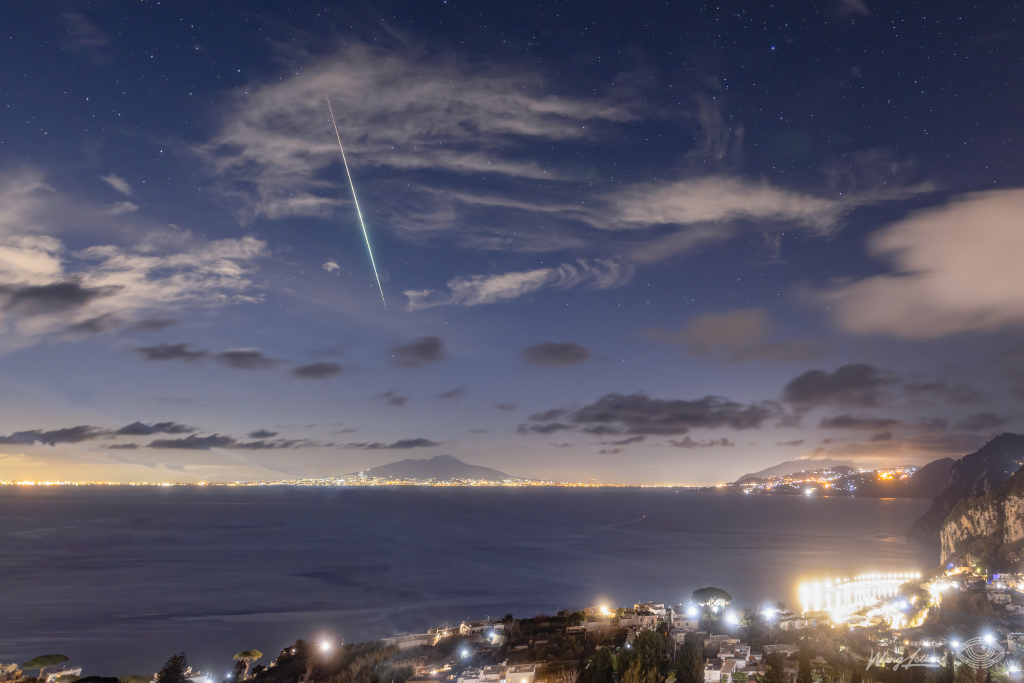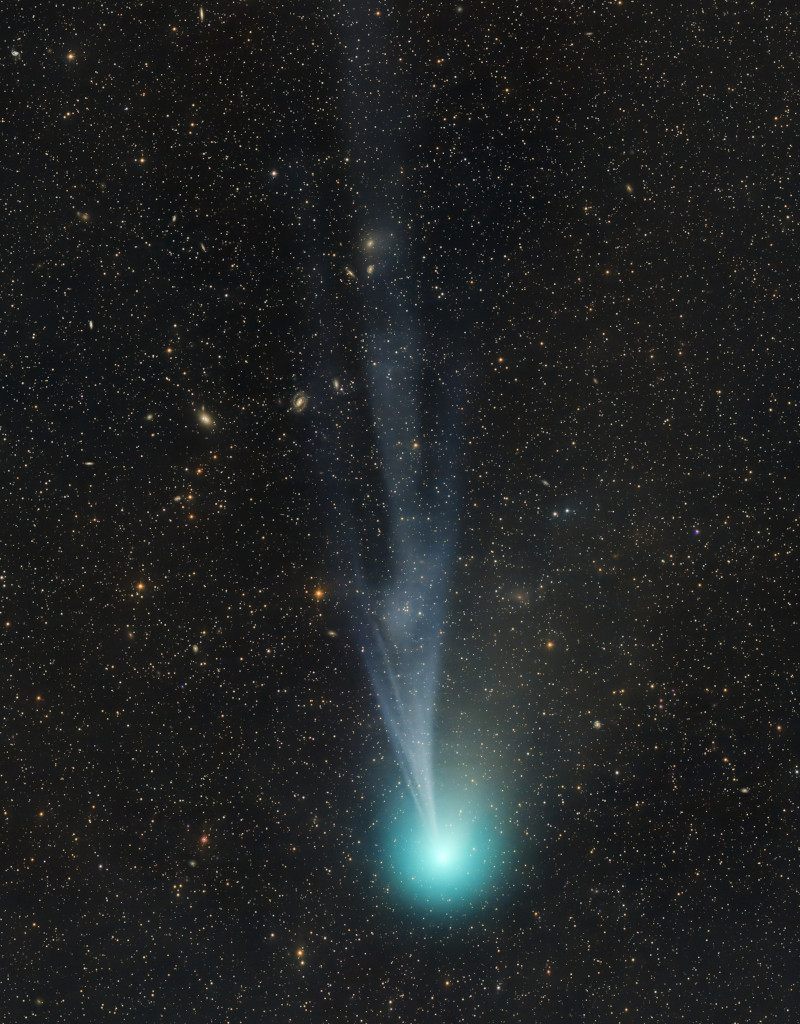
Nombre total de pages vues
20/02/2024
MYSTERES SOUS L'EAU DES LACS - Quand le brochet est à l'affût

ASTRONOMY - AM1054: Stars Form as Galaxies Collide
2024 February 20
Image Credit: NASA, ESA, STScI; Processing: J. English (U. Manitoba); Science: M. Rodruck (Penn State U. & Randolph-Macon C.) et al.;
Text: Jayanne English (U. Manitoba).
Explanation: When galaxies collide, how many stars are born? For AM1054-325, featured here in a recently released image by the Hubble Space Telescope, the answer is millions. Instead of stars being destroyed as galaxy AM1054-325 and a nearby galaxy circle each other, their gravity and motion has ignited stellar creation. Star formation occurs rapidly in the gaseous debris stretching from AM1054-325’s yellowish body due to the other galaxy’s gravitational pull. Hydrogen gas surrounding newborn stars glows pink. Bright infant stars shine blue and cluster together in compact nurseries of thousands to millions of stars. AM1054-325 possesses over 100 of these intense-blue, dot-like star clusters, some appearing like a string of pearls. Analyzing ultraviolet light helped determine that most of these stars are less than 10 million years old: stellar babies. Many of these nurseries may grow up to be globular star clusters, while the bundle of young stars at the bottom tip may even detach and form a small galaxy.
19/02/2024
MYSTERES SOUS L'EAU DES LACS - Danse avec les nymphéas

ASTRONOMY - Looking Sideways from the Parker Solar Probe
2024 February 19
Video Credit: NASA, JHUAPL, Naval Research Lab, Parker Solar Probe; Processing: Avi Solomon; h/t: Richard Petarius III;
Music: Beethoven's Symphony No. 7, Second Movement; Music Credit: Wikimedia Commons
Explanation: What's happening near the Sun? To help find out, NASA launched the robotic Parker Solar Probe (PSP) to investigate regions closer to the Sun than ever before. The PSP's looping orbit brings it nearer to the Sun each time around -- every few months. The featured time-lapse video shows the view looking sideways from behind PSP's Sun shield during its 16th approach to the Sun last year -- from well within the orbit of Mercury. The PSP's Wide Field Imager for Solar Probe (WISPR) cameras took the images over eleven days, but they are digitally compressed here into about one minute video. The waving of the solar corona is visible, as is a coronal mass ejection, with stars, planets, and even the central band of our Milky Way Galaxy streaming by in the background as the PSP orbits the Sun. PSP has found the solar neighborhood to be surprisingly complex and to include switchbacks -- times when the Sun's magnetic field briefly reverses itself.
18/02/2024
MYSTERE SOUS L'EAU DES LACS - Rassemblement de silures

ASTRONOMY - Hoag's Object: A Nearly Perfect Ring Galaxy
2024 February 18
Image Credit: NASA, ESA, Hubble; Processing: Benoit Blanco
Explanation: Is this one galaxy or two? This question came to light in 1950 when astronomer Arthur Hoag chanced upon this unusual extragalactic object. On the outside is a ring dominated by bright blue stars, while near the center lies a ball of much redder stars that are likely much older. Between the two is a gap that appears almost completely dark. How Hoag's Object formed, including its nearly perfectly round ring of stars and gas, remains unknown. Genesis hypotheses include a galaxy collision billions of years ago and the gravitational effect of a central bar that has since vanished. The featured photo was taken by the Hubble Space Telescope and reprocessed using an artificially intelligent de-noising algorithm. Observations in radio waves indicate that Hoag's Object has not accreted a smaller galaxy in the past billion years. Hoag's Object spans about 100,000 light years and lies about 600 million light years away toward the constellation of the Snake (Serpens). Many galaxies far in the distance are visible toward the right, while coincidentally, visible in the gap at about seven o'clock, is another but more distant ring galaxy.
17/02/2024
AUTOMOBILE - INVENTIONS QUI N'ONT JAMAIS VU LE JOUR - Pneus en polyuréthane (plastique) - 2

ASTRONOMY - Meteor over the Bay of Naples
2024 February 17
Image Credit & Copyright: Wang Letian (Eyes at Night)
Explanation: A cosmic dust grain plowing through the upper atmosphere much faster than a falling leaf created this brilliant meteor streak. In a serendipitous moment, the sublime night sky view was captured from the resort island of Capri, in the Bay of Naples, on the evening of February 8. Looking across the bay, the camera faces northeast toward the lights of Naples and surrounding cities. Pointing toward the horizon, the meteor streak by chance ends above the silhouette of Mount Vesuvius. One of planet Earth's most famous volcanos, an eruption of Mount Vesuvius destroyed the city of Pompeii in 79 AD.
16/02/2024
ASTRONOMY - Structure in the Tail of Comet 12P/Pons-Brooks
2024 February 16
Image Credit & Copyright: Dan Bartlett`
Explanation: Heading for its next perihelion passage on April 21, Comet 12P/Pons-Brooks is growing brighter. The greenish coma of this periodic Halley-type comet has become relatively easy to observe in small telescopes. But the bluish ion tail now streaming from the active comet's coma and buffeted by the solar wind, is faint and difficult to follow. Still, in this image stacked exposures made on the night of February 11 reveal the fainter tail's detailed structures. The frame spans over two degrees across a background of faint stars and background galaxies toward the northern constellation Lacerta. Of course Comet 12P's April 21 perihelion passage will be only two weeks after the April 8 total solar eclipse, putting the comet in planet Earth's sky along with a totally eclipsed Sun.
15/02/2024
AUTOMOBILE - INVENTIONS QUI N'ONT JAMAIS VU LE JOUR - Pneus en polyuréthane (plastique)

ASTRONOMY - STEVE: A Glowing River over France
2024 October 28 STEVE: A Glowing River over France Credit & Copyright: Louis LEROUX-GÉRÉ Explanation: Sometimes a river of hot gas flo...

-
2022 September 26 All the Water on Planet Earth Illustration Credit: Jack Cook, Adam Nieman, Woods Hole Oceanographic Institution ; Data ...
-
2025 May 11 The Surface of Venus from Venera 14 Image Credit: Soviet Planetary Exploration Program , Venera 14 ; Processing & Copyri...



